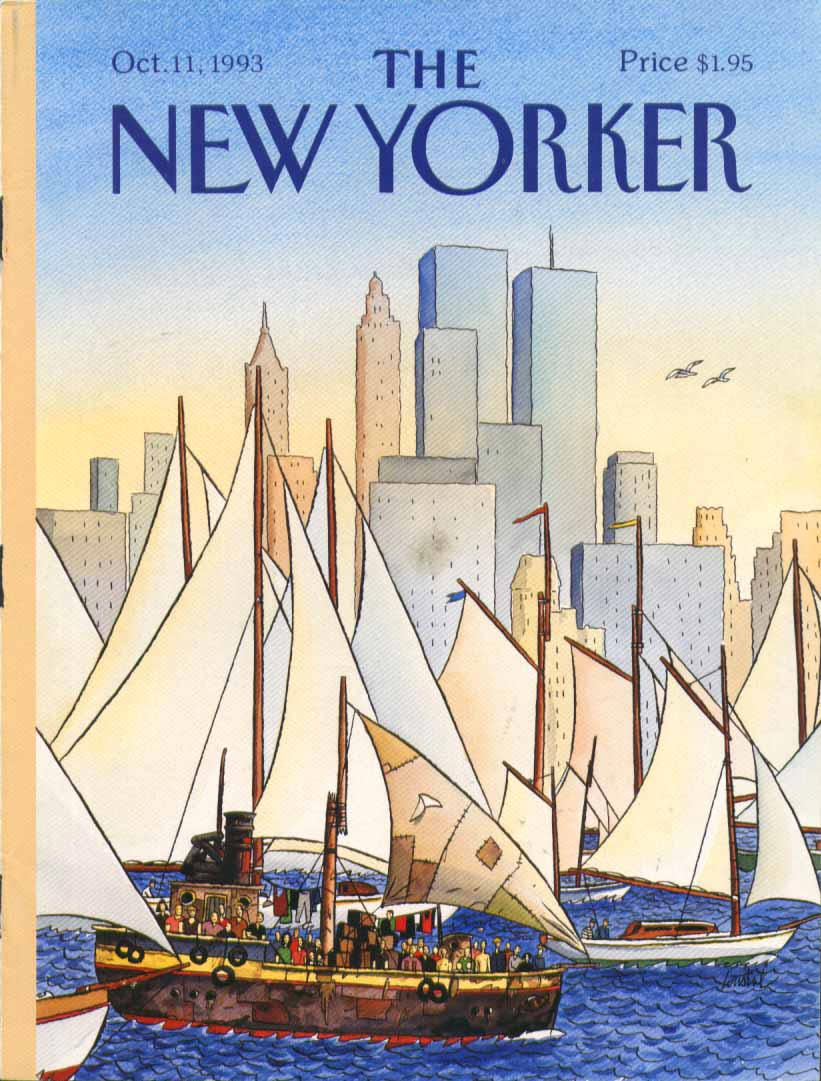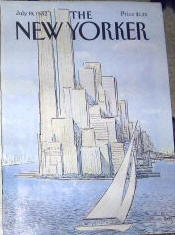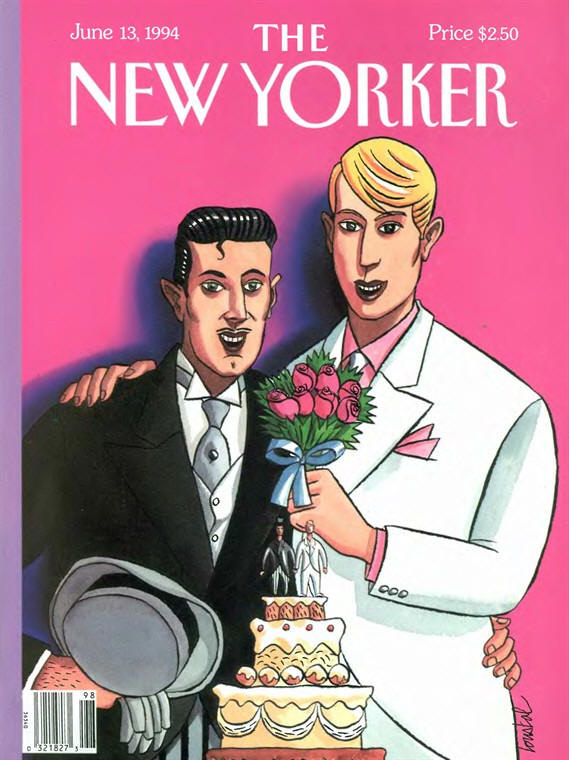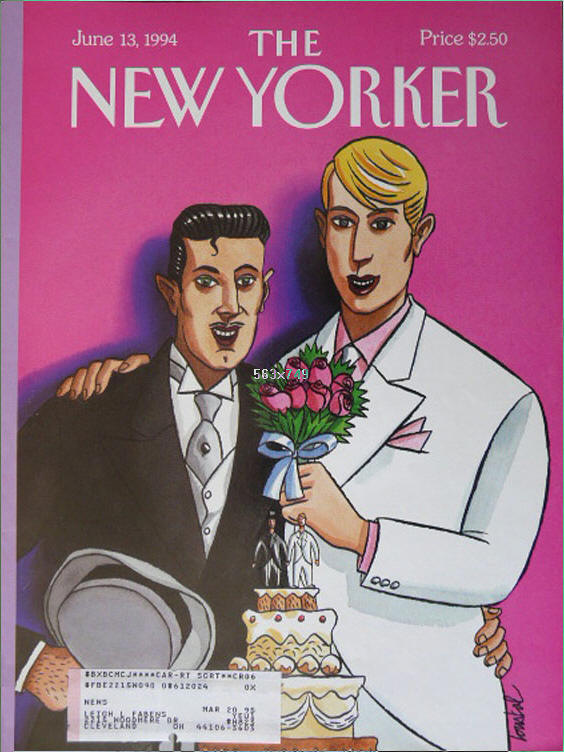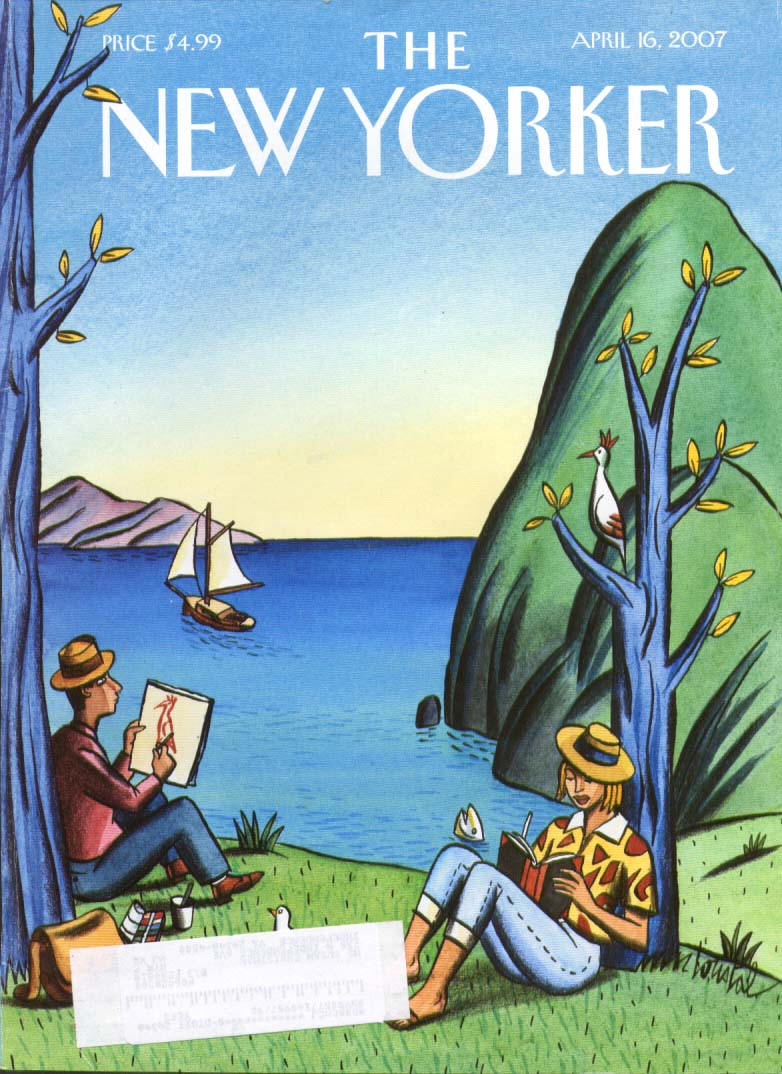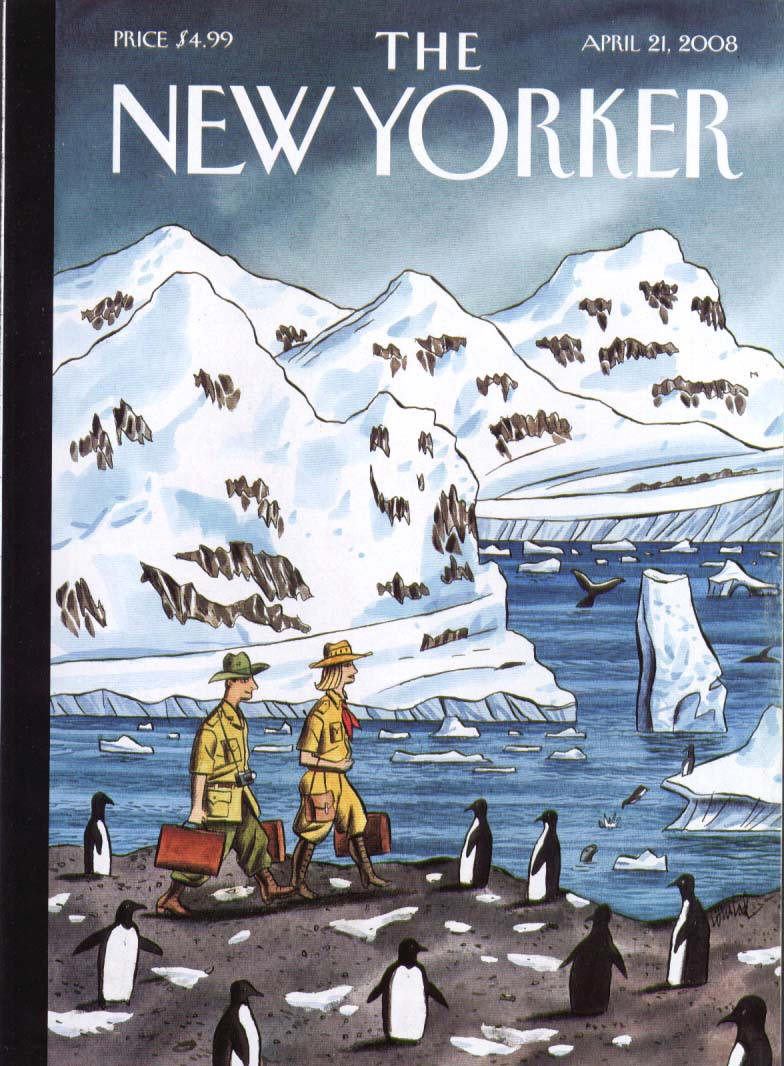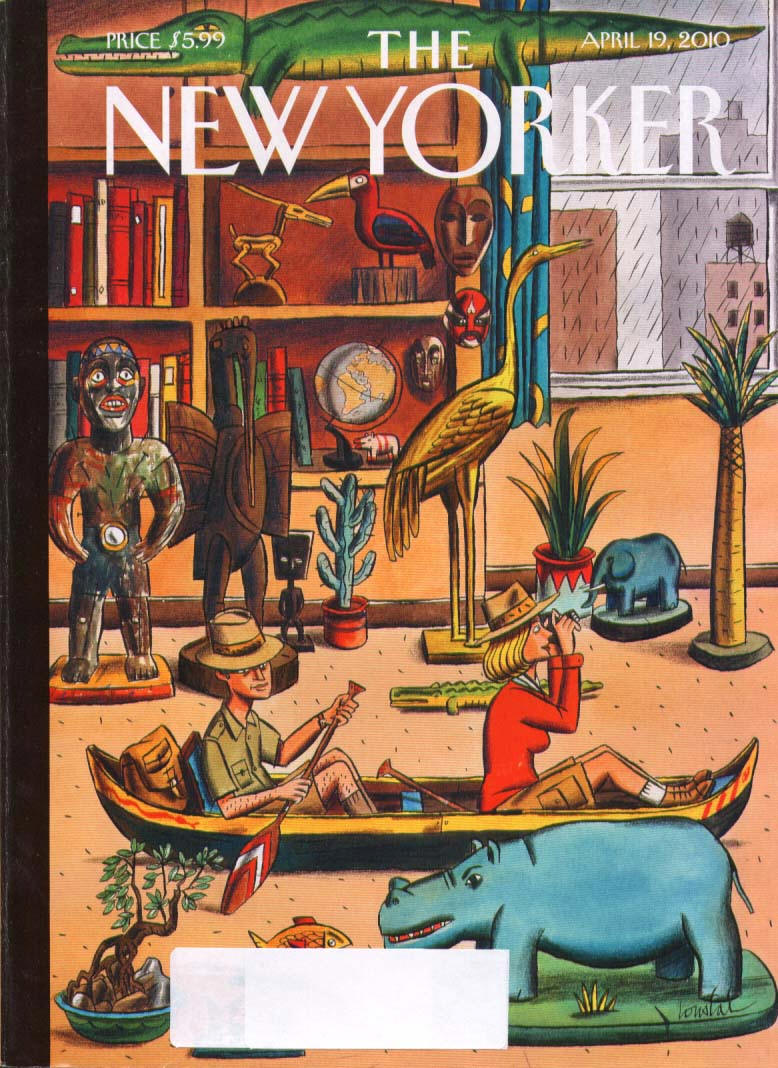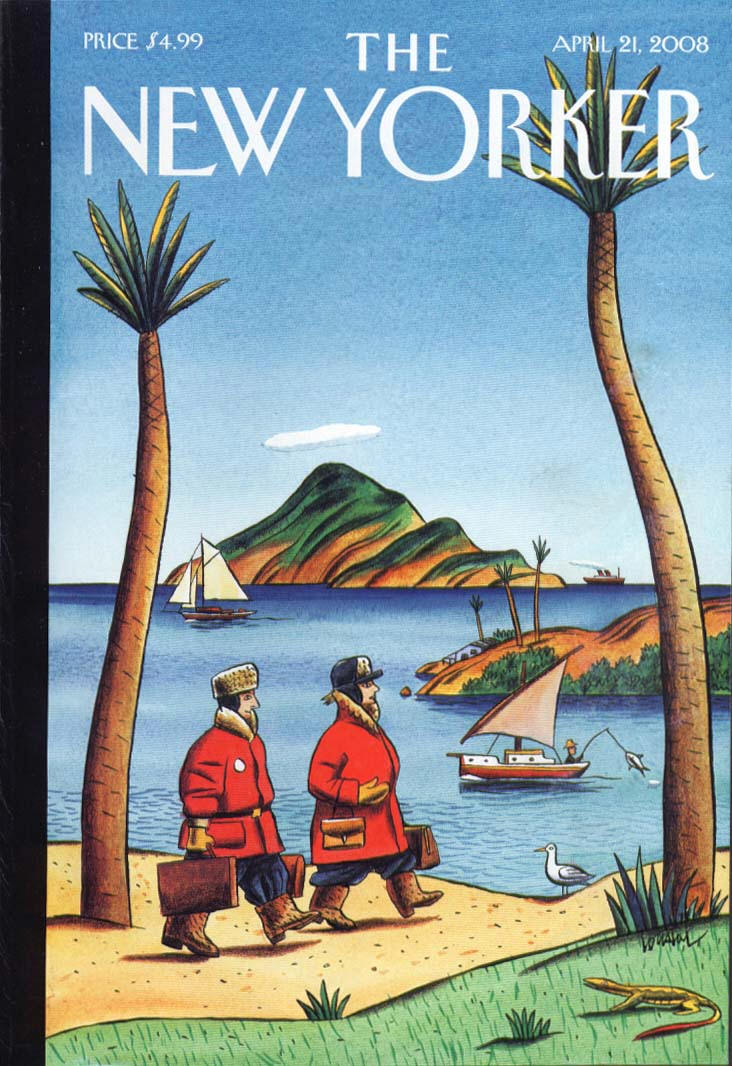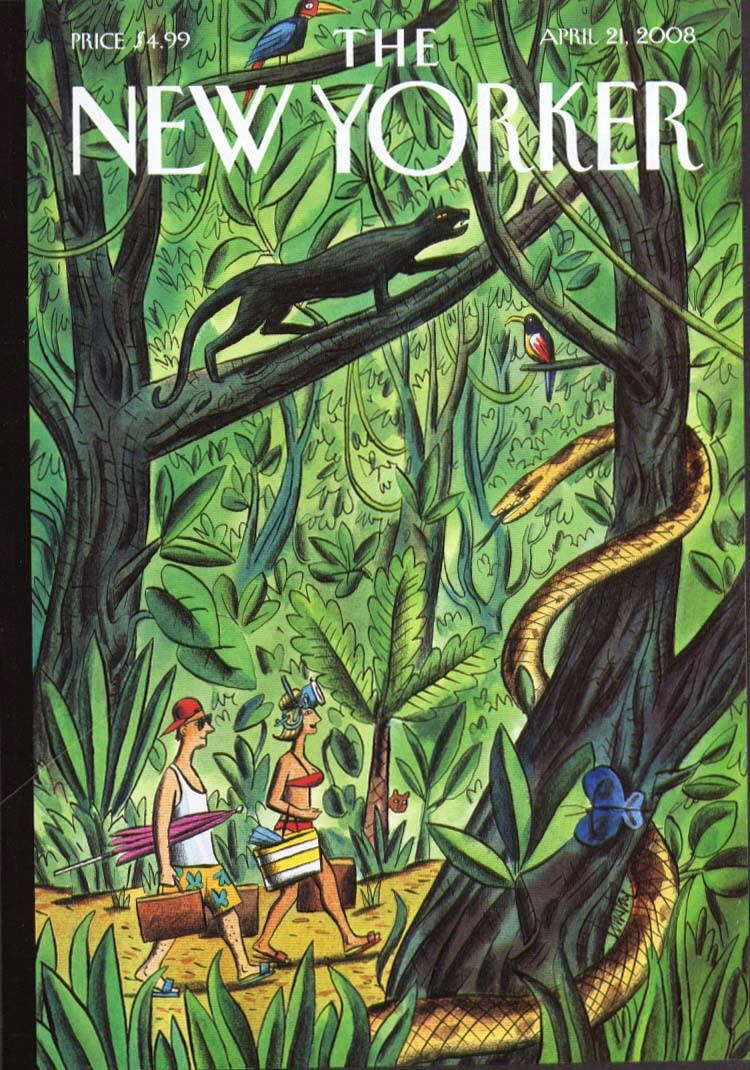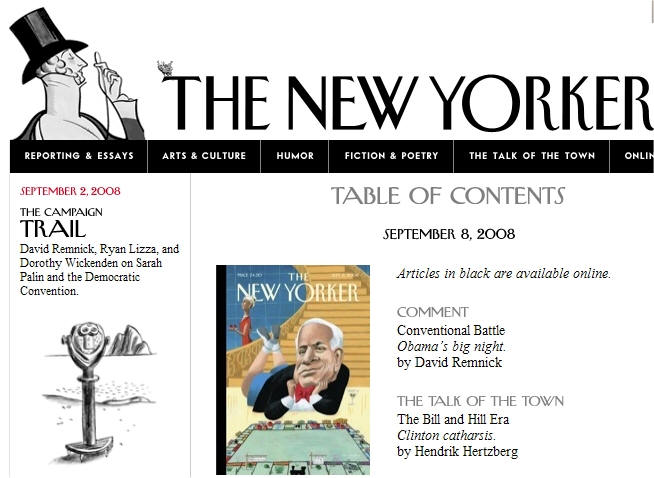
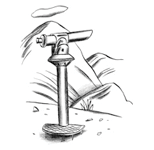 spot Loustal New Yorker 08-09-2008 website New Yorker
spot Loustal New Yorker 08-09-2008 website New Yorker
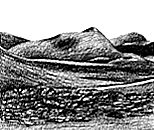 the New Yorker the spot Loustal. (28 july 2008)
the New Yorker the spot Loustal. (28 july 2008)
Loustal, in The New Yorker: 6/13/1994, 9/26/1994, 12/26/1994, 1/30/1995, 1/15/1996,
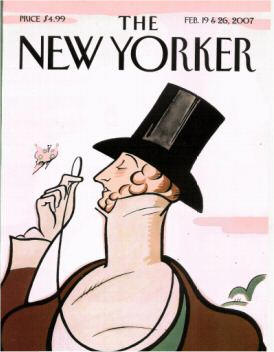 Loustal: the New Yorker 19 &26 febr. 2007 |
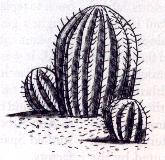 |
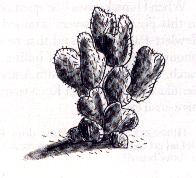 |
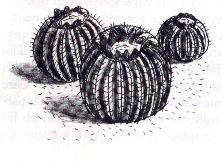 |
|
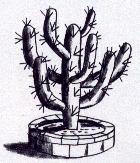 |
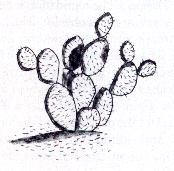 |
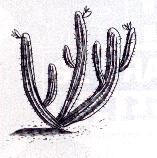 |
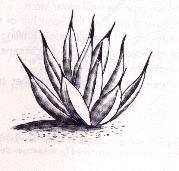 |
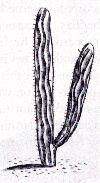 |
Loustal
`The new Yorker`
april 9, 2007
Loustal
`The new Yorker`
June 4, 2007
|
|
These are 2 New Yorker magazines with covers showing the New York skyline including the World Trade Center's North and South towers. Both are views from New York Harbor with sailboats in the foreground. The first one is dated July 19, 1982 and the cover was drawn by Arthur Getz. The 2nd one is dated October 11, 1993, was drawn by Jacques de Loustal and is titled: Back in the New World. The boat in the front has patched sails and mast and is full of people. |
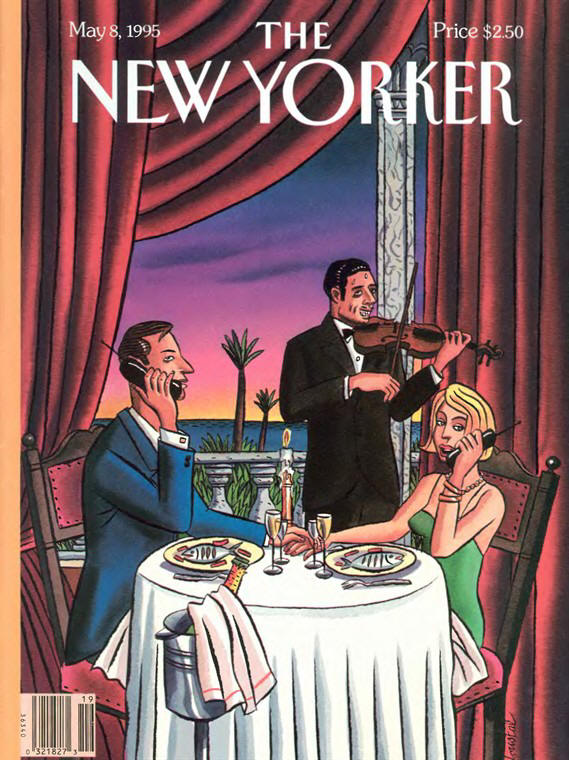
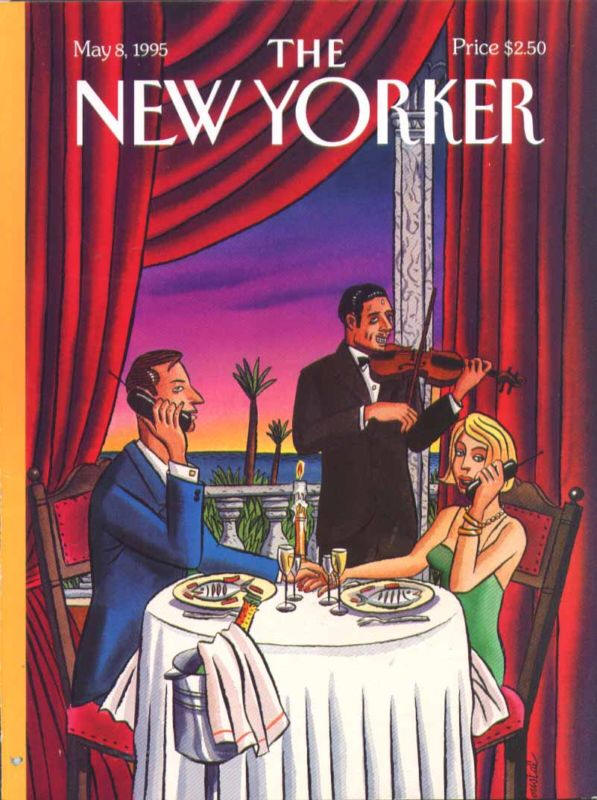
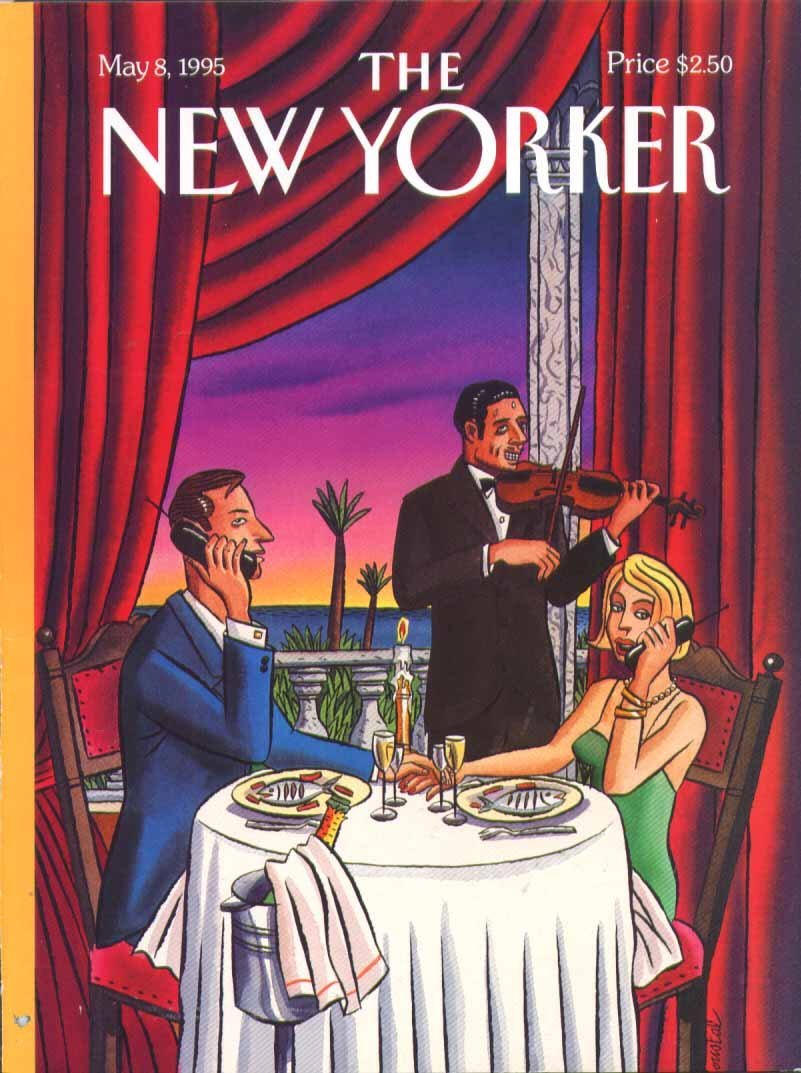
New Yorker cover Loustal cellphone fiddler 5/8 1995
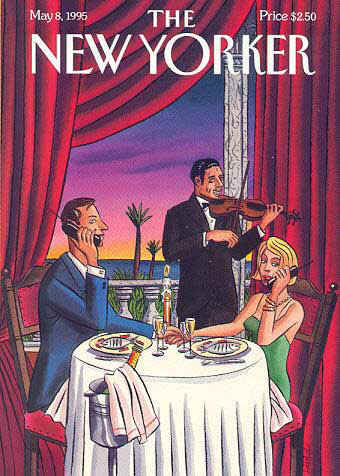
5/8/95 : Loustal cover Sweet Nothings.
Titel : COVER: Sweet Nothings In : The New Yorker, ISSN 0028-792X, 08-05-1995
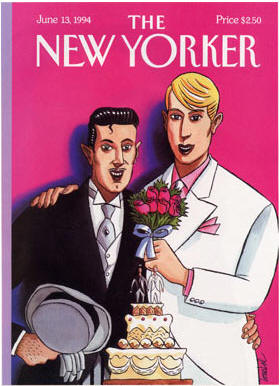
"June Grooms" / by Jacques de Loustal.
cover of The New
Yorker,
v. 70, no. 17 (June 13, 1994).
Summary: The pose
for a gay wedding photo. --
This whimsical cover to The New
Yorker during Gay Pride Month is a
refreshing reprieve simply because
there is no corresponding article about
the event. In New York and many other
locales, Gay Pride month, along with its
celebrations and parades, is simply
becoming Christmas in Summer.
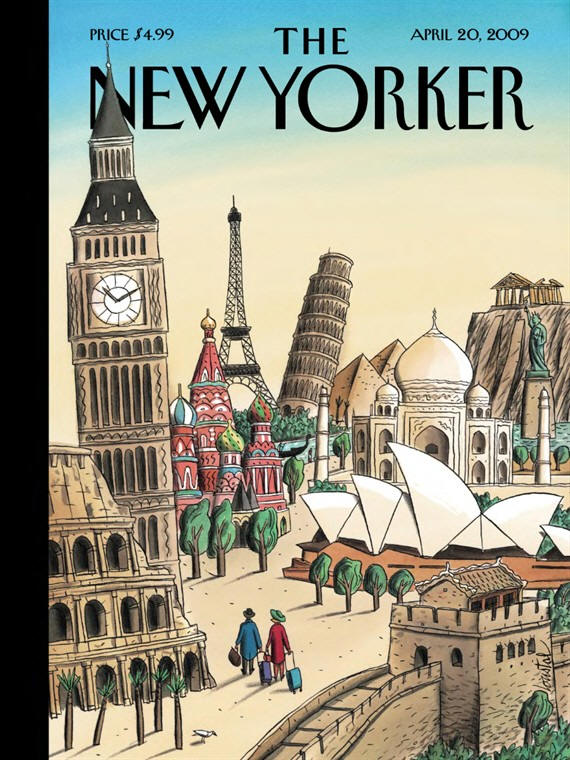
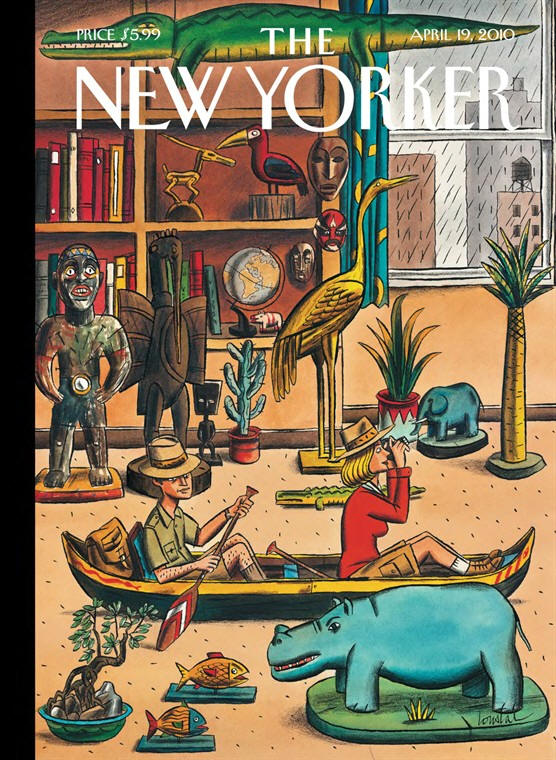
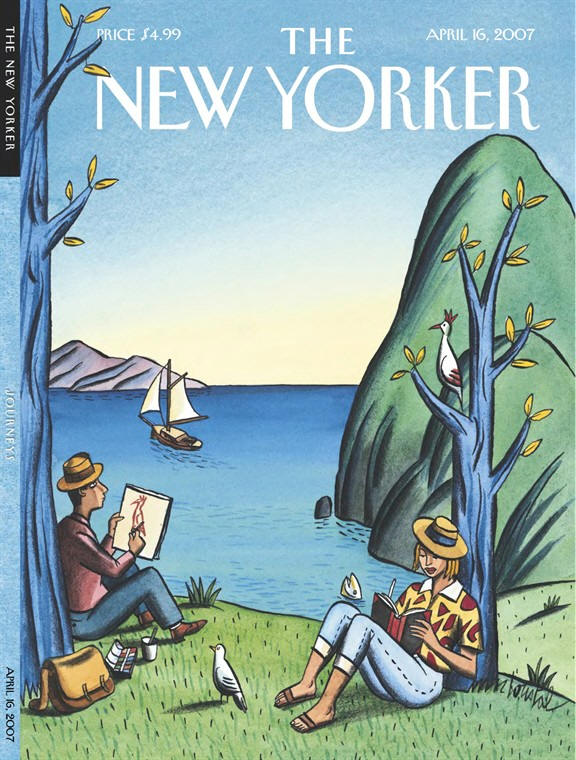
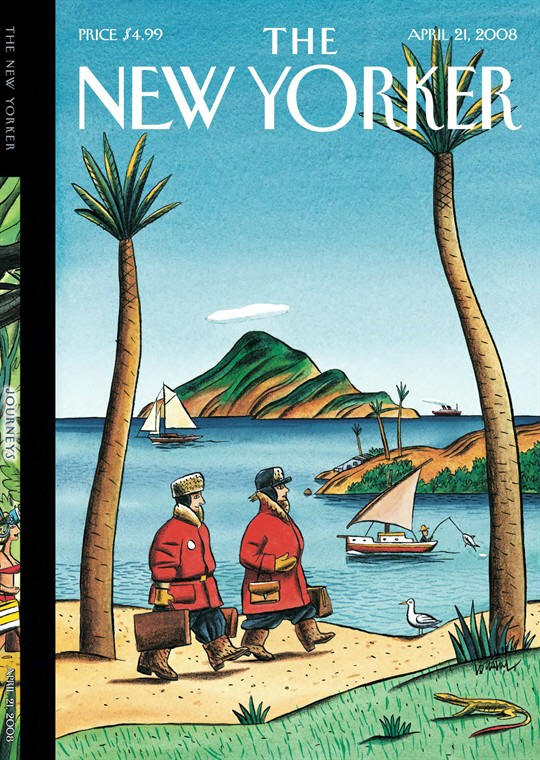
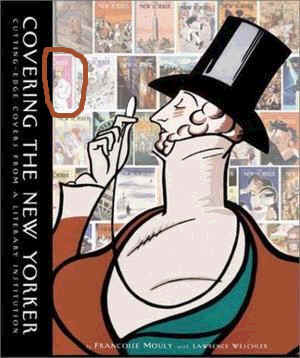
Shifts in the culture are prime source material for the cover artists. Often, the reaction from readers is linked to their feelings about the phenomenon or trend portrayed. The artist is the messenger, sometimes hailed as a hero, sometimes pilloried. A 1994 June wedding cover by Jacques de Loustal (page 129) showed two men about to cut the wedding cake on a background of shocking pink. Many readers were angry, while many others called and asked for a print of the image they could frame.
http://www.abbeville.com/newyorker/introduction.asp
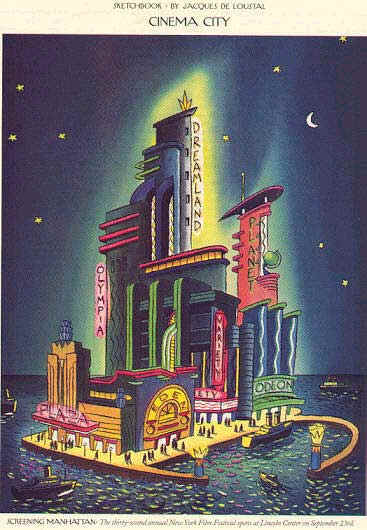
The New Yorker, Sept 26, 1994
9/26/94 Brief Encounter cover by Art Spiegelman, Cinema City by Jacques de Loustal, p. 79.
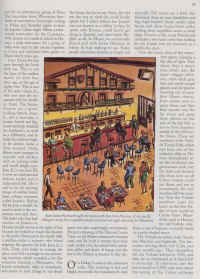
Loustal ill. p.37
The New Yorker, Jan 15, 1996
12/26/94 - 1/2/95 : Loustal ill for "This Side of Paradise," p. 62.
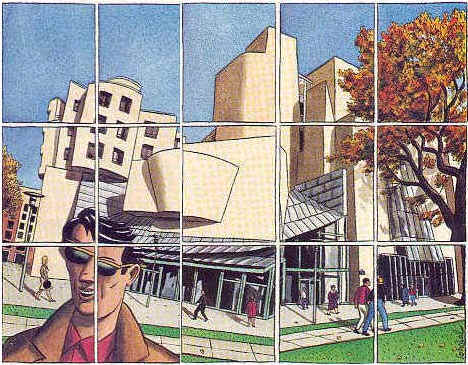
The New Yorker, Jan 30, 1995
Frank Gerhry's building, an alluring
neighbor to the controversial National Library, the last of Mitterrand's
"grand projects," is drawing big crowds. Is this the new Pompidou
Plaza?
1/30/95 : American Center in Paris sketchbook by Loustal.
Titel : SKETCHBOOK: The American Center in Paris In : The New Yorker,
ISSN 0028-792X, 30-01-1995, 78-79 (2) Auteur : Jacques de Loustal
January 30, 1995
Sketchbook
THE AMERICAN CENTER IN PARIS [ABSTRACT]
SKETCHBOOK showing the American Center in Paris. Frank Gehry's building, an
alluring neighbor to the controversial National Library, the last of
Mitterand's "grands projets," is drawing big crowds. Is this the new
Pompidou…
by Jacques de Loustal
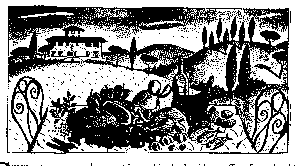
1/15/96 : Loustal illustration for The Homesick Restaurant article.
New Yorker cover Loustal artist vacation 4/16 2007
New Yorker cover de Loustal polar vacationers 4/21 2008
New Yorker cover Loustal stay-at-home safari 4/19 2010
New Yorker cover de Loustal island vacationer 4/21 2008
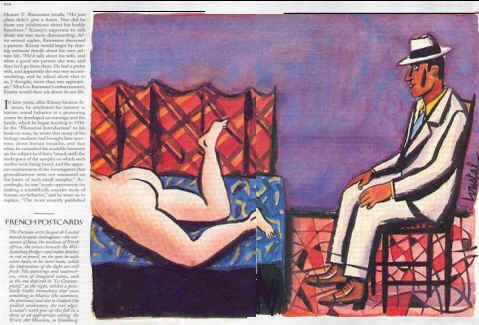 |
FRENCH POSTCARDS The Parisian artist Jacques de Loustal travels to exotic destinations--the volcanoes of java, the medinas of North Africa, the streets beneath the Williamsburg Bridge-and makes sketches, in ink or pencil, on the spot; he adds colors later, in his hotel room, while his impressions of the light are still fresh. His paintings and watercolors, even of imagined scenes, such as the one. depicted in Le Contemplatif, " at the right, exhibit a peculiarly Gallic immediacy that owes something to Matisse (the sunniness, the prurience) and also to Godard (the studied carelessness, the cool edge). Loustals work goes up this fall in a show at an appropriate setting: the Erotic Art Museum, in Hamburg.
August 25, 1997 |
8/25 & 9/1/97 : Loustal's French Postcards, p. 104.
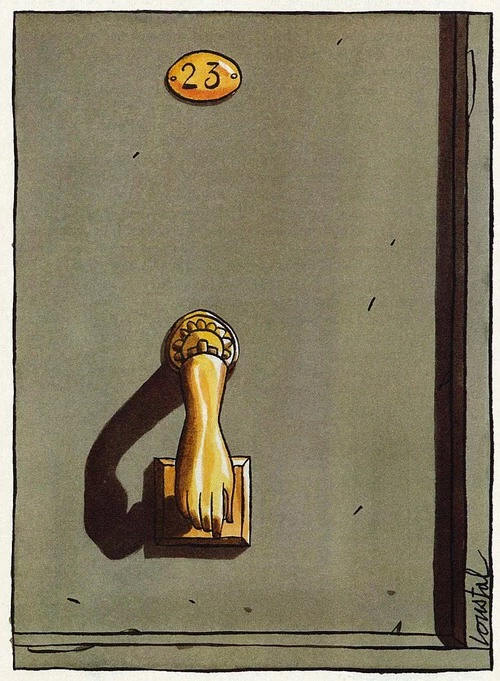
november 24, 2001 issue
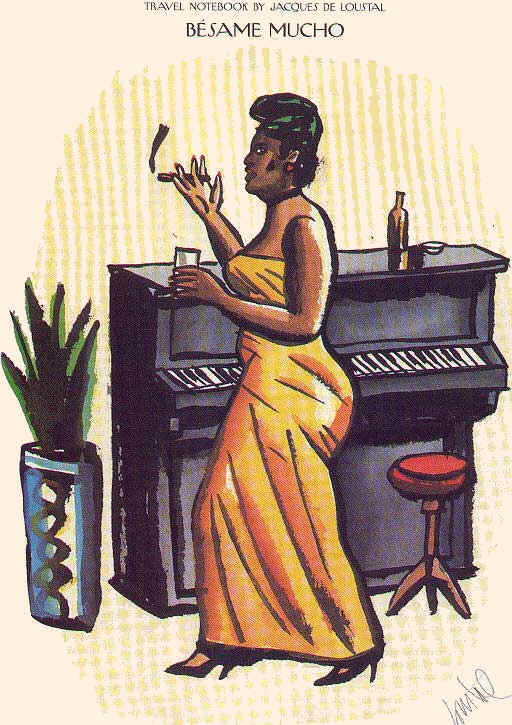
The New Yorker, Jan 26, 1998
1/26/98 Jacques de Loustal's Travel Notebook Bésame
Mucho, p. 74-5.
Titel : TRAVEL NOTEBOOK - Besame Mucho In : The New
Yorker, ISSN 0028-792X,
26-01-1998, 75 (1)
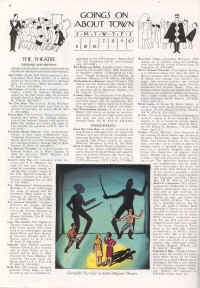
THE NEW YORKER (12/04/1999) :
Corneille’s ‘Le Cid’, at BAM’s Majestic Theatre, illustration
couleur (8,2 x 9,8)
The New Yorker, April 12, 1999
23-07-2001: Letter from Cambodia, 'Home for dinner'
24/31-12-2001 3 ill. : 'My mother', memory by Amy Tan (p:82), 'Visiting George', memory by Nadine Gordimer (p:88), 'Paris diary (1922)', memory by Marvis Gallant (p: 102)
19-26-08-2002 5 ill. : 'A sandwich', (p: 139), 'As the french do', (p: 142/ 143),'Sweet Memory', (p: 149) ,'The domestic male', (p: 155),
23-09-2002 ''Where's Willy ?' (p: 57)
12-05-2003 'The light stuff- Anals of aviation : Learning to fly the Goodyear blimp'
09-06-2003 'Death of a chef',
THE NEW YORKER
Venerable weekly magazine established in 1925 as a venue for now-legendary wits like Dorothy Parker, Robert Benchley, and (slightly later) James Thurber. The New Yorker went through a mere three editors in the subsequent 66 years, during which time its unimpeachable literary standards and sophisticated cartoons claimed a unique place in the genteel culture of East Coast WASPs.In 1985 mighty media man S.I. Newhouse bought the magazine; in 1992 he handed its editorial reins to Tina Brown, the high-powered Briton who had famously salvaged the 1984 relaunch of Vanity Fair. Many feared that Brown's celebrity- and advertiser-friendly predilections would coarsen The New Yorker's tone, and they were not reassured by the introduction of full-page photographs, ad-rich theme issues, and pious chronicles of the lives of media moguls. Brown, who quickly raised The New Yorker's profile, circulation, and spending, claimed fidelity to the irreverent spirit of magazine founder Harold Ross. Suspicions of professional favor trading between Brown and her husband, Random House head Harry Evans, abound; the couple claims they are more prone to competition than collusion.
When Tina Brown became the editor of The New Yorker, she hired Raw co-founder (and Art Spiegelman's wife) Françoise Mouly as the new art director. The magazine soon became friendlier to comic book and strip artists, both European (Mattotti, Götting, Swarte & Loustal) and American.
The New Yorker is a weekly magazine dedicated to ideas. It is timeles and immediate, energetic and thoughtful, serious and funny. The New Yorker is about good writing, a point of view, and a deeper understanding of the world. A "typical" issue of The New Yorker contains an eclectic mixture of political and business coverage, social commentary, fiction, humor, art, poetry, and criticism. Contributors to The New Yorker include both recognized talents of long standing and newly discovered voices.
An Extremely Preliminary Look at Comics Artists in
The New Yorker
Version 3.1, 5/27/1998
by Michael Rhode
When Tina Brown became the editor of the New Yorker in October, 1992, comics artists began
working for the magazine. According to Dave Mazzucchelli (Comics Journal 194, p. 72),
"When Tina Brown became the editor, the art director, Chris Curry, was able to start
using a lot of artists she'd always wanted to use, but hadn't been able to, including
artists from RAW and other odd comics." Brown hired Raw co-founder (and Art
Spiegelman's wife) Françoise Mouly as the new art director. The magazine soon became
friendlier to comic book and strip artists, both European (Mattotti, Götting, Swarte
& Loustal) and American. Not everyone seems happy with the reworked magazine; Bill
Griffith, who has worked for them, used his Zippy strip on August 2, 1997 to satirize the
magazine. Zippy's daughter, Meltdown wanted to see a cartoon on every page of the New
Yorker, and Zippy asked, "But then, where would they put all th' deep, insightful
articles on O.J. and th' lastest fashions, Melty?" Meltdown suggested, "Maybe in
th' National Star or Cosmo,
Daddy!" Griffith returned to his theme on April 2, 1998, with a strip character
saying, "This isn't about cartoons, Bob. It's about ad revenue!"
This is an index based just on what I've noticed; I haven't looked through every issue to
find every piece. In fact, there might be additional artwork in the issues I've listed
here. I'd be glad to hear of any corrections or additions. Additions by Chris Pyle of the
University of Kentucky marked with a *. Mark Nevins pointed out that Götting's work began
appearing in issues in the fall of 1996.
He also notes that European artists (Philippe) Petit-Roulet, Pierre Clement (who signs his
work with a small p inside a large C much like the copyright symbol), Dupuy-Berberian,
Walter Minus, and possibly Lionel Koechlin among others have done small uncredited
drawings. Bart Beatty highlighted Max's work. Alec Stevens pointed out his own work. My
memory is telling me that a Peter Kuper
Masks piece appeared, but I couldn't find it. "#" marks the additions or changes
made for the current version. Argentinian comics artist "Nine" apparently had a
caricature of Bill Clinton sometime in 1997-1998 and I'm trying to find the exact date. As
this has grown quite long, I've provided an artist's cross-reference at the end.
